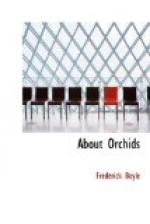a great number of
Cypripedium insigne received
at St. Albans, and “established,” Mr. Sander
noted one presently of which the flower-stalk was
yellow instead of brown, as is usual. Sharp eyes
are a valuable item of the orchid-grower’s stock-in-trade,
for the smallest peculiarity among such “sportive”
objects should not be neglected. Carefully he
put the yellow stalk aside—the only one
among thousands, one might say myriads, since
C.
insigne is one of our oldest and commonest orchids,
and it never showed this phenomenon before. In
due course the flower opened, and proved to be all
golden! Mr. Sander cut his plant in two, sold
half for seventy-five pounds to a favoured customer,
and the other half, publicly, for one hundred guineas.
One of the purchasers has divided his plant now and
sold two bits at 100 guineas. Another piece was
bought back by Mr. Sander, who wanted it for hybridizing,
at 250 guineas—not a bad profit for the
buyer, who has still two plants left. Another
instance occurs to me while I write—such
legends of shrewdness worthily rewarded fascinate
a poor journalist who has the audacity to grow orchids.
Mr. Harvey, solicitor, of Liverpool, strolling through
the houses at St. Albans on July 24, 1883, remarked
a plant of
Loelia anceps, which had the ring-mark
on its pseudo-bulb much higher up than is usual.
There might be some meaning in that eccentricity, he
thought, paid two guineas for the little thing, and
on December 1, 1888, sold it back to Mr. Sander for
200l. It proved to be
L. a. Amesiana,
the grandest form of
L. anceps yet discovered—rosy
white, with petals deeply splashed; thus named after
F.L. Ames, an American amateur. Such pleasing
opportunities might arise for you or me any day.
The first name that arises to most people in thinking
of warm orchids is Cattleya, and naturally. The
genus Odontoglossum alone has more representatives
under cultivation. Sixty species of Cattleya are
grown by amateurs who pay special attention to these
plants; as for the number of “varieties”
in a single species, one boasts forty, another thirty,
several pass the round dozen. They are exclusively
American, but they flourish over all the enormous
space between Mexico and the Argentine Republic.
The genus is not a favourite of my own, for somewhat
of the same reason which qualifies my regard for O.
vexillarium. Cattleyas are so obtrusively
beautiful, they have such great flowers, which they
thrust upon the eye with such assurance of admiration!
Theirs is a style of effect—I refer to
the majority—which may be called infantine;
such as an intelligent and tasteful child might conceive
if he had no fine sense of colour, and were too young
to distinguish a showy from a charming form.
But I say no more.




